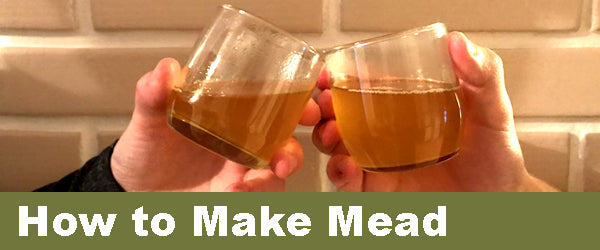
Posted by The Home School in the Woods Team on
We teach our kids about historical people, places, and events. We even teach them about historical food recipes. But what about beverages? Are these important to include in our children’s history curriculum too?
We say, yes! After all, beverages have a story to tell. One we want to talk to you about today is mead – the oldest alcoholic drink in the world. We’ll share with you the history behind mead, plus our non-alcoholic honey mead recipe from our Renaissance and Reformation Project Passport.
Before we get started on the history of mead, we want to assure you that we are absolutely not encouraging you to give your child real mead! We have a kid-friendly version that will provide them with an idea of what this honey wine tastes like without actually containing any alcohol.
What Is Mead?
Mead is an alcoholic beverage consisting of honey, water, and yeast. When the following ingredients are allowed to sit for an extended period of time, they ferment and create a sweet-tasting wine-like beverage, which has been referred to in history as mead, or “nectar of the gods.”
Mead is known for tasting similar to Riesling and can range from sweet to dry. Mead can be spiced anyway you like, from cloves, nutmeg, cinnamon, orange or lemon slices, mint, ginger, and sweet herbs such as basil.
The History of Mead
This honey wine is considered to be the first alcoholic beverage ever to be consumed by man (even before wine and beer!). While we don’t know precisely when or how this beverage was invented, historians believe that it was likely discovered before the wheel was invented. Some say that humans probably stumbled upon this beverage out in nature – as mead can accidentally be made when honey, wild yeast, and rainwater mix together and ferment.
Throughout history, mead became a popular beverage to consume during wedding celebrations, hence the term “honeymoon.” Mead was often gifted to newlyweds since many cultures believed that mead brought fertility. By tradition, guests would shower the couple with enough mead to last them a full month (moon) after their wedding.
Mead is referenced in history by practically every culture and every era – including China, Greece, Egypt, India, England, Spain, France, Russia, and many Celtic nations. However, it gained its fame during the Dark Ages, mainly the Renaissance and Reformation period, as well as the Middle Ages, when Vikings notoriously consumed it.
Throughout the Renaissance and Reformation, mead was regularly consumed by peasants, noblemen, kings, and saints. It can even be traced back to the Court of King Arthur and even Charles II. Mead also shows up in historical fiction like the Medieval epic poem, Beowulf, and the many works of William Shakespeare.
Do People Still Drink Mead Today?
As beer gained popularity throughout the centuries, people lost interest in mead. Beer became accessible and affordable and therefore became the drink of choice among commoners. Mead, however, was still consumed by the upper classes, especially kings.
Today, mead is still enjoyed by several countries such as Africa and Central Europe. It’s also a popular beverage in Ireland and is enjoyed on St. Patrick’s Day with corned beef and cabbage or a hearty Irish stew.
Mead never became widely available in the United States but has been making a comeback as many people are starting small commercial meaderies. It can even be found at Renaissance festivals and some local wine stores.
How to Make Mead at Home
Traditional mead recipes, as well as many beverages of the Renaissance and Reformation era, contained alcohol. However, we decided to create a non-alcoholic version that kids can enjoy too. The recipe contains no yeast or fermentation, just apple juice, honey, and water.
Making mead is simple and is an easy beverage you and your kids can make together. It’s the perfect drink to sip while swimming in the summer sun. We also found that our kids loved to drink this while they pretended to be knights, Vikings, kings, and queens!
For more on why dress-up is a valuable teaching tool when learning history, check out our blog post, Imagination + History = Dressup.
Ingredients:
2 c. apple juice
4 c. honey
6 c. water
Optional additions: cloves, nutmeg, cinnamon, orange or lemon slices, mint, ginger, or a sweet herb such as basil.
Directions:
- Place all liquid ingredients in a pot and bring to a boil.
- If adding other fruits, spices, or herbs, add into the mixture and reduce heat to a simmer for 30 minutes.
- Strain and refrigerate. You may wish to add in other fruits or herbs to continue to savor the drink while chilling.
- Enjoy and serve cold!
Now You’re a Mead-Making Expert!
Now that you know how to make a great non-alcoholic mead recipe, you can store some in your fridge and tell your guests all about this delicious historical beverage.
If you’re looking for more historical beverages and meals during the time when mead was famous, check out our Renaissance and Reformation Project Passport or our Middle Ages Project Passport. Wondering what a Project Passport is? Our blog post “So… Just What is A Project Passport?” will tell you all about it.
Want to be “in the know” when we publish historical recipes? Be sure to sign up for our newsletter at the bottom of our website’s homepage! This will keep you in the loop every time we post a new recipe. You can also follow us on Facebook or Instagram for more updates.

Thanks for sharing! We are going to make this for our Reformation Party.